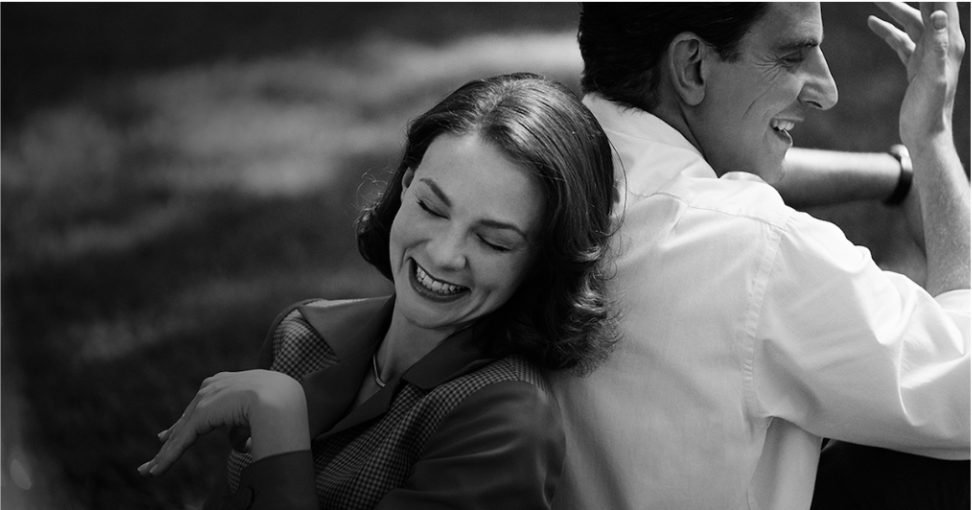A Review of Maestro

The acclaimed Leonard Bernstein once said “A work of art does not answer questions, it provokes them. And its essential meaning is in the tension between the contradictory answers.” His thought-provoking perspective and character are captured in the recently released movie, Maestro.
Maestro (2023), the second directorial feature film from Academy Award Nominee Bradley Cooper, produced by Martin Scorsese, attempts to be an insightful look into the life of American conductor and composer, Leonard Bernstein, who composed famous works like West Side Story (1957) and On the Waterfront (1954).
First and foremost, this picture is not as much a biopic as it is a marriage analysis of Bernstein’s relationship with his wife, Felicia Montealegre, played by Academy Award Nominee Carey Mulligan. Bernstein himself is played by Cooper, who, as mentioned before, is also the director of the feature film. The chemistry between the two is portrayed through a fascinating and oftentimes emotional narrative that lists the accomplishments of Bernstein along the way, but, while the subject matter of the film is an interesting concept, the execution becomes a pretentious uphill battle for the audience to climb, and I was left with very mixed feelings walking out of the theater.
Cooper delivers a charismatic performance as Bernstein, but at times feels a bit overplayed. The large nose and accent attempts so strongly to transform the actor into the character, and it works at times, but at certain moments felt ridiculous. The makeup on older Bernstein felt a bit fake and overdone as well, but I suppose it got the job done. Looking at real life photos of the man, Cooper does have some significant features that strongly resemble what he actually looked like.
The performance that really sold me, however, was Mulligan as Bernstien’s wife, Felicia Montealegre. She brings a very careful approach to the character, and what started as a regular performance brought tears to my eyes by the end. A lot of the character’s best scenes come from Mulligan’s facial expressions and physical behavior, which she is phenomenal at expressing in a subtle way. The final act was truly impressive with her overall reactions to tragic events occuring in her life, and the actions Bernstein made involving his infamous gay affairs.
Bernstein’s actions as a lover, which involved these multiple complicated affairs, was an aspect of this film which was seen rather than discussed through his subtle kisses and bedroom occurrences with men. His sexuality is never directly told, but rather implied throughout the film, with characters like David Oppenheim (Matt Bomer) and Tom Cothran (Gideon Glick) appearing in and out of scenes as other love interests. Montealegre’s standpoint on these affairs, which Bernstein was very open about, is also mainly addressed through subtle glances, and the occasional passive aggressive acknowledgement. There are a couple arguments which eventually address the affair through a small plot point involving the couple’s daughter, Jamie Bernstein, played by Maya Hawke, but for the most part, the film tends to be interested in taking a more careful, visual approach. Despite these complications, Bernstein and Montealegre remained married from 1951 until Montealegre died of cancer in 1978.
The cinematographer, Matthew Libatique, who is known for working on other popular projects such as Requiem for a Dream (2000) and Black Swan (2010) did an exceptional job at making the film look visually stunning. Every shot in the film does an incredible job at capturing the beautiful and grand essence of Leonard Bernstein’s life and music. The first act is in black and white, and the rest is in color to separate the time jump from the 1940s to the 1960s (and the lesser discussed finale of the film, which takes place in the late 80s during Bernstein’s final years.) While this artistic decision is aesthetically pleasing, it added little to no value on the impact the film left on me, and it felt overall unnecessary due to the clear and distinguishable change in makeup the characters go through to show their aging process.
The film is at its best when Cooper is conducting as Bernstein, the most notable being in Ely Cathedral, a 6 minute long sequence of Symphony No. 2 in C minor Resurrection played live by the London Symphony Orchestra. The camera lingers on Cooper throughout most of the scene, who learned to conduct the entire orchestra just for the role. While I did not enjoy most of Cooper’s performance, little details like these did a very good job at capturing the grand essence of Bernstein, and the true talent he possessed.
Accompanying the beautiful visuals and rather inconsistent acting is the sound design and score, which subtly travels throughout the film, the majority being different works Bernstein composed and conducted.
In a Netflix interview, Steve Morrow, the Sound Mixer of the film, and Tom Ozanich, the Dialogue and Re-Recording Mixer, talked about how they included extras actually talking in the background of certain party sequences to give the dialogue between the protagonists a certain authenticity, rather than the typical pre-recorded studio quality. Sounds like the rustling of the wind and trees in other scenes are meant to spark emotional responses from the audience alongside the score, which frequently plays alongside these smart technical decisions.
While certain bits of this film were a bit pretentious, the little smart details managed to hold my attention through all of its 2 hours and 9 minutes. Many features are at least noteworthy enough to give the film a whirl.
Maestro, written and directed by Bradley Cooper is in select theaters from November 22, 2023, but it’s available on Netflix December 20, 2023, so give it a chance and check it out if you have the time.
Noah Andersen is a writer for The Talon. In his free time he loves to watch films and collect records.







